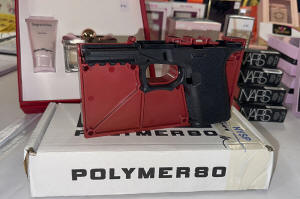Supreme Court upholds Biden rule requiring serial numbers and background
checks for ghost guns
[March 27, 2025]
By LINDSAY WHITEHURST
WASHINGTON (AP) — The Supreme Court on Wednesday upheld a Biden
administration regulation on the nearly impossible-to-trace weapons
called ghost guns, clearing the way for continued serial numbers,
background checks and age verification requirements for buying the kits
online.
The 7-2 opinion found that existing gun laws allow regulation of the
kits increasingly linked to crime. It comes after President Donald Trump
ordered a review of federal gun policy that could undermine or reverse
regulations championed by his predecessor.
Sales of the homemade firearms grew exponentially as kits allowing for
easy at-home building came into the market, Justice Neil Gorsuch wrote
in the majority opinion. “Some home hobbyists enjoy assembling them. But
criminals also find them attractive,” he said.
The number of ghost guns found at crime scenes around the country has
also soared, according to federal data. Fewer than 1,700 were recovered
by law enforcement in 2017, but that number grew to 27,000 in 2023,
according to Justice Department data.
Since the federal rule was finalized, though, ghost gun numbers have
flattened out or declined in several major cities, including New York,
Los Angeles, Philadelphia and Baltimore, according to court documents.
Manufacturing of miscellaneous gun parts also dropped 36% overall, the
Justice Department has said.

Ghost guns are any privately made firearms without the serial numbers
that allow police to trace weapons used in crime. The 2022 regulation
was focused on kits sold online with everything needed to build a
functioning firearm — sometimes in less than 30 minutes, according to
court documents.
Ghost guns have been used in high-profile crimes, including a mass
shooting carried out with an AR-15-style ghost gun in Philadelphia that
left five people dead. Police believe a ghost gun used in the slaying of
UnitedHealthcare’s CEO in Manhattan was made on a 3D printer rather than
assembled from a kit of the kind at the center of the Supreme Court
case.
Finalized at the direction of then-President Joe Biden, the “frame and
receiver” rule requires companies to treat the kits like other firearms
by adding serial numbers, running background checks and verifying that
buyers are 21 or older.
Gun groups challenged the rule in court in the case known as Garland v.
VanDerStok. Most crimes are committed with traditional firearms, not
ghost guns, they argued. It's legal for people to build their own
firearms at home, the challengers said, arguing that the Bureau of
Alcohol, Tobacco, Firearms and Explosives overstepped its authority by
trying to regulate the kits.
The Supreme Court majority disagreed, pointing out that the law gives
the ATF the power to regulate items that can be quickly made into
working firearms.

[to top of second column]
|

A ghost gun that police seized from an organized shoplifting crime
ring is on display during a news conference at the Queens District
Attorney's office in New York City, Nov. 26, 2024. (AP Photo/Ted
Shaffrey, File)

“The ‘Buy Build Shoot’ kit can be 'readily converted' into a firearm
too, for it requires no more time, effort, expertise, or specialized
tools to complete,” Gorsuch wrote, referring to a specific product.
Some kits may take more time to build into guns and therefore fall
outside the ATF’s power, he wrote, but many popular kits are subject
to regulation.
In response to the ruling, a Justice Department spokesperson said
the administration would “continue to support and defend the Second
Amendment rights of all Americans.”
Gun safety groups celebrated the ruling, with Everytown Law
executive director Eric Tirschwell saying the rule also had broad
support from law enforcement. “Fundamentally, today's decision
confirms the ghost gun industry is dead as a viable business model,"
he said.
A Michigan woman whose son lost an eye when he was accidently shot
by a friend who bought a ghost gun before he was old enough to
legally buy a typical weapon also applauded. “We are deeply relieved
by today’s ruling, which will help ensure that a tragedy like ours
never happens again,” she said.
New Jersey Attorney General Matt Platkin said the ATF policy is a
major factor in two years of record-low numbers of shootings in his
state. “These are common-sense regulations on ghost guns that all
too often end up in the hands of felons,” he said.
The court previously expanded Second Amendment rights with a finding
that modern gun regulations must fit within historical traditions.
The justices also struck down a firearm regulation from President
Donald Trump’s first administration, a ban on gun accessories known
as bump stocks that enable rapid fire.

In a dissent, Justice Clarence Thomas wrote that the ghost gun rule
should meet the same fate. The kits, he wrote, are only firearm
parts and shouldn't be subject to a regulation that could open the
door to rules on other popular weapons. “Congress could have
authorized ATF to regulate any part of a firearm or any object
readily convertible into one," he wrote. “But, it did not.”
Justice Samuel Alito also filed his own dissent.
___
Associated Press writer Darlene Superville in Washington and Geoff
Mulvihill in Cherry Hill, New Jersey, contributed to this report.
All contents © copyright 2025 Associated Press. All rights reserved |